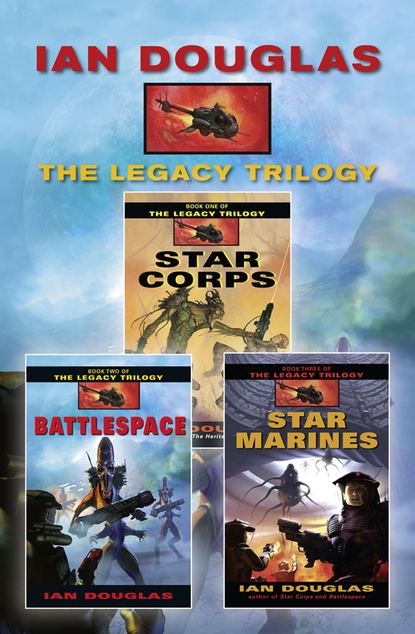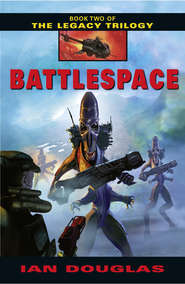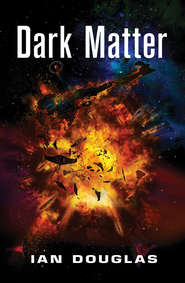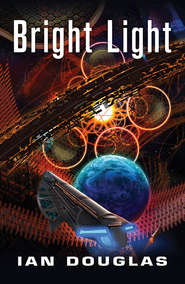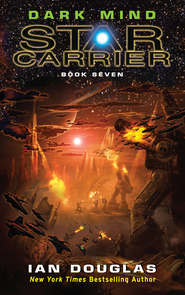По всем вопросам обращайтесь на: info@litportal.ru
(©) 2003-2024.
✖
The Complete Legacy Trilogy: Star Corps, Battlespace, Star Marines
Настройки чтения
Размер шрифта
Высота строк
Поля
Approaching Ishtar
1312 hours ST
“… and four … and three … and two … and one … release!”
A surge of acceleration pinned Captain Warhurst against his seat as powerful magnetic fields flung the TAL-S Dragonfly clear of the vast, flat underbelly of Derna’s reaction mass tank and into empty space. Seven additional Dragonflies, each with its attached lander, drifted out from the transport’s docking bays at the same moment, the formation perfectly symmetrical with Derna at the center. Derna’s massive AM drive had been shut down, since the gamma emissions from matter-antimatter annihilation would have fried the landers and all on board.
Long minutes passed, and the landers continued to pace the Derna, sharing with the huge transport her current velocity toward the planet ahead. Once the landers were well clear of the deadly kill zone of Derna’s AM drive venturi, the transport and her two consorts again triggered their drives, continuing to decelerate.
From the point of view of the eight landers, Derna, Algol, and Regulus appeared to be accelerating back the way they’d come at ten meters per second per second. In free fall, the Dragonflies hurtled toward the looming curve of the planet, now some two million kilometers ahead.
Dragon One’s microfusion plasma thrusters kicked in as the craft pirouetted into its proper alignment, accelerating. They would hit Ishtar’s atmosphere six hours before the transports decelerated into orbit, a critical timing element of the Krakatoa mission.
Still strapped immobile in his seat, encased in his Mark VII armor and with his LR-2120 clipped to its carry mount on his front torso, Warhurst closed his eyes and reviewed the op program.
“D-day, the sixth of June 1944,” the voice of General King echoed in his noumenal reality, a replay of the general’s address of some hours before. “The Allied invasion forces were threatened by massive shore battery emplacements at Pointe du Hoc, west of Omaha Beach. Elements of the U.S. Army Rangers assaulted the battery from the sea, scaling forty-meter cliffs with mortar-fired grapnels trailing climbing ladders and ropes.”
In his noumenal display Warhurst could see the grainy, black-and-white images of historical documentary films, showing primitively clad soldiers climbing sheer cliffs from tiny, tin-box boats bobbing in the surf at the base of the rocks as King’s voice droned on.
“After a fierce firefight at the top of the cliffs, with opposing forces at times only meters apart, the Rangers overran the position, suffering heavy casualties in the process. Their heroism and dedication to achieving their mission were in no way lessened by the fact that the shore batteries thought to have been mounted at Pointe du Hoc had, in fact, been removed. The gun emplacements were empty.”
One of the great minor ironies of military history, Garroway thought, but not the sort of thing to inspire the troops before the big fight. Marines liked to think their actions counted for something.
“Objective Krakatoa is very much of a stripe with the Pointe du Hoc shore batteries,” King’s voice went on. The image unfolding in Warhurst’s noumenon showed the mountain, An-Kur, seen from the air by computer imagery. “Since it has been ten years objective since the planetary defense batteries within that mountain fired, we can hope the facility has been abandoned or fallen into disrepair. The modern Ahannu do not possess the technological prowess of their ancient ancestors.”
And that, Warhurst thought, was a royal load of crap. Whatever else you said about the An of ten thousand years ago, they built their machines and tools to last. The likelihood of the An-Kur facility being a one-shot weapon was so remote as to be practically invisible. Certainly, the Marine assault team wasn’t going to bet the farm on the possibility.
The recitation finally reached the part of the record he was interested in. He could have fast-forwarded through the recorded memories, but he’d wanted to marvel again at King’s clumsy exhortation.
All too little was known about the objective, save what had been gleaned from orbit by mapping satellites. Two point heat sources were known, one near the peak, the other on the mountain’s east slope, about one-third of the way up from the base. The mountain was clearly a natural landform, but one that had been extensively reworked, probably over millennia. The slopes were preternaturally smooth, and terraced in places, with stacked rocks holding back walls of earth. Absolutely nothing was known of the mountain’s interior workings, but infrared scans suggested a tunnel complex of considerable extent and in three dimensions, connecting the two hot spots, which were almost certainly entrances of some sort.
Computer analysis of the IR readings had produced a 3D map of the complex. What could not be analyzed or deduced was what might be waiting for them down there. There were some similarities to underground works discovered during the past century on Earth’s moon, especially in the Tsiolkovsky Crater site on the lunar far side. Created by An colonizers ten thousand years ago, the Tsiolkovsky complex was thought to be typical of ancient An military defenses, and as such it might hold clues for an assault on An-Kur. Every man in Black Dragon had a complete set of floor plans for both Tsiolkovsky and An-Kur in their Mark VII armor computers.
But … was it defended? That remained to be seen. Pointe du Hoc had been an empty emplacement vigorously defended by German troops; perhaps An-Kur was the reverse, a live weapon not defended at all.
Maybe. And maybe pigs could fly without the benefits of genetic engineering.
The Dragonfly gave a hard jolt as it encountered the first tenuous wisps of Ishtar’s atmosphere at a velocity of close to forty thousand kilometers per hour.
Lander Dragon Three
Ishtar, approaching Krakatoa LZ
1620 hours ST
Private First Class John Garroway—his rank had not been Van Winkled after all—closed his eyes, trying to ignore the irritating tickle of sweat between his eyes, unreachable behind his helmet visor. The Dragonfly was trembling, bucking, lurching unsteadily in its descent, the roar of atmosphere building now like a waterfall just beyond the lander’s thin hull. The TAL-S was using the lander module slung beneath its wasp-waist belly as a heat shield now, riding the disk-shaped module down on a cushion of flame.
An image was being fed to Garroway’s noumenon from a camera mounted forward beneath the craft’s bulbous cockpit, but there was boringly little to see. They were coming into Ishtar’s atmosphere on the night side, which also, by design, was currently the anti-Marduk side. Marduk itself was invisible, hidden behind the curving loom of Ishtar; the star Llalande 21185 was a shrunken red ember just above the bloody crescent of Ishtar’s horizon, little more at this distance than a ruby star. Ishtar’s night side was completely black, a featureless darkness swiftly expanding to fill the noumenal feed.
Even so, Garroway couldn’t quite bring himself to close the feed window and sever that slender, less-than-helpful link with the universe outside of Dragon Three’s shuddering hull. The alternative was the claustrophobic near-darkness of the LM’s squad bay, fully armed and armored Marines crammed into seats so narrow they were literally wedged against one another’s shoulders and gear packs. Unable even to turn his helmet, Garroway could only stare at the back of the seat in front of him or down at his own lap below the LR-2120 clipped to his torso mount. Watching the darkness blotting out the stars in his noumenon was infinitely preferable to simply waiting out the thunder of reentry, blind as well as helpless.
The men and women around him were not quite the strangers they’d been when he’d emerged from cybehibe. He’d been expecting either the hazing traditionally handed out to newbies in a military unit or the ostracism reserved for men who’d not yet proven themselves in combat. The 44th Marine Regiment, however, was a newly created ad hoc unit thrown together expressly as a part of 1 MIEU. As such, it included both veteran Marines and kids right out of boot camp.
The command constellation, Garroway had learned, had quite a bit of experience, as did his platoon commander, Lieutenant Kerns. Gunnery Sergeant Valdez, who ran 2nd Squad, had fought in Uzbekistan, Venezuela, and Egypt. She was a fifteen-year veteran from Escondido, California, and had the war stories to tell to prove it. The squad’s plasma gunner was Sergeant Nathaniel Easton Deere—“Honey” Deere to his squad mates—a kid from El Dorado, Kansas, with a nasty scar on his forehead and quite a few war stories of his own, even though he’d only been in for eight. Sergeants Foster and Dunne, Lance Corporals Womicki and Brandt, and PFC Cawley had had some time in, ranging from two years for Chuck Cawley, a red-haired agroworker from Iowa, to seven years for Sergeant Richard “Well” Dunne, a onetime underdome ’combganger from the wastelands west of the Chicago Desert.
Tom Pressley and Kat Vinita were both brand-new Marines fresh out of boot company 1097, however, and Roger Hollingwood and Gerrold Garvey—“Hollywood” and “Gravy” to their buddies—both were alumni of Company 1099. The five of them were the FNGs of 2nd Squad, Third Platoon; the idea was that five fucking new guys could learn from the seven experienced Marines in the squad, a kind of do-or-die on-the-job training.
But all of them, experienced or not, were quite literally in the same boat. If there were any tendencies toward newbie-baiting in 2nd Squad, they were being well controlled by Gunny Valdez and Honey Deere.
Second Squad had spent most of the past twenty-two hours—all but three hours of forced cybesleep that ship-morning, followed by a twenty-minute sermon by General King—running through training sims downloaded from the command constellation’s AI, Cassius.
“You don’t need to be fucking heroes,” Valdez had told them all as they sat on a noumenal hillside at the edge of an AI-generated Ishtaran forest, a tangled mass of purples, blacks, and reds. The light there was dim, a perpetual red twilight from a ruby-hued, shrunken sun little larger than a bright star. “We want live Marines on this op, not dead heroes. You new guys … keep your heads down and stay out of the line of fire. I especially want you to keep well to either side of Honey’s thundergun. The fringe-bleed from a PG-90 will fry your ass if you’re too close, armor or no armor. You old hands … keep an eye on the newbies in your fire teams. Don’t let them get lost, don’t let them shock-freeze, don’t let them play hero. Remember the first time you all were in a firefight, and think about what it’s like for them.”
That lecture had been a damned sight more useful than the canned talk by General King—a warmed-over hash of platitudes served up around some historical two-vees about Army troops landing in Europe a couple of hundred years before. The pep talk hadn’t exactly been encouraging; of the 150 Rangers who’d stormed the Pointe du Hoc cliffs on June 6, 1944, only ninety were left when they were relieved two days later—forty percent casualties to take a battery of guns that had, in fact, already been moved. If that was the stuff of heroism, Garroway wanted no part of it.
Numbers in the lower right corner of his noumenal inner window gave the dwindling range to the LZ and estimated time to landing. Another fifteen minutes to go.
The LM gave another lurch, then dropped sharply, like a string-cut puppet.
Fists clenched in carbon-fiber gauntlets, sweat dribbling incessantly and maddeningly down his unreachable face, Garroway wondered if he was going to be sick inside his armor.
Lander Dragon One
Ishtar, approaching Krakatoa LZ
1625 hours ST
They’d dropped at last below the cloud deck, and Warhurst shifted to his tactical noumenon. A composite image generated by the lander’s AI presented the visible spectrum overlaid by infrared and a 3D contour map showing elevations, targets, and way points in lines and symbols of white light. Dragon One was over Ishtar’s night side, but the lander’s chin cameras rendered the scene with near-noontime illumination; some of the contour lines didn’t quite match up with the landforms rushing past below, however. Either the terrain had changed a bit in ten years, or the first expedition’s mapping satellites had transmitted less than precise data on Ishtar’s topography.
At the moment—and thanks to careful work by the MIEU’s planning staff, both human and cybernetic—Ishtar’s night side was also the side forever tide-locked, facing away from the super giant planet Marduk. The red dwarf star Llalande 21185 provided Ishtar’s daylight, but the heat came from the sullenly glowing super-Jovian gas giant called Marduk and from the friction of internal tidal stresses. According to the briefing information downloaded to Warhurst’s implant, surface temperatures on Ishtar ranged from over forty degrees Celsius on the side facing Marduk, to minus fifty on the anti-Marduk side, temperatures only slightly affected by the cycles of night and day induced by the distant red-dwarf sun.
The landscape below was one of glaciers and ice-locked mountains. Volcanoes glowed and thundered on the horizon in every direction, and in some places rivers of lava encountered ice in searing explosions of steam and molten rock. In a flash, a tortured plain of cracked and fractured ice-rimed rock gave way to water, huge, dark swells thick with drifting mountains of ice. Alphanumerics in the corner of Warhurst’s noumenal vision identified the water as the western edge of the Abgal, the Great Sea that bordered Ishtar’s habitable belt between ice and fire.
None of the other Dragonflies was visible, again according to plan. The eight landers had scattered across half a hemisphere as they entered Ishtar’s atmosphere, with the idea that the more scattered the targets, the tougher it would be for the ground defenses to target them. Warhurst was gladder than ever now that he’d insisted on the additional landers and troops. So much could go wrong, and they faced odds that made the Giza Plateau look like a pleasant afternoon in a sandbox.
Lightning flared ahead, illuminating the bellies of thickening clouds. The imbalance of temperatures in the opposite hemispheres, hot and cold, meant lots of energy in Ishtar’s weather systems, and that meant large and frequent storms across the habitable belt. Maybe that storm ahead would scramble the enemy’s tracking system.
Maybe … maybe …
The trouble was, so little was known about the modern Ahannu, and even less about the ancient An who’d built Ishtar’s defenses. Ten thousand years ago they’d forged an interstellar empire and colonized parts of Earth with a technology humankind had yet to match. They’d already thrown a nasty surprise at the first expedition; what other surprises were hidden down there, in clouds and darkness?
The lander gave a savage jolt, rolling hard to the left and dropping sharply. The AI pilot extended the stubby wings a bit, angling them to grab the air, and increased the power to the plasma thrusters in the Dragonfly’s belly. Four minutes to the target …
Ishtar’s planetary defenses were almost certainly automated, running on programs written thousands of years ago. That was both a major problem and a slender hope for the assault team. Automated weapons would have faster than human reflexes and responses; at the same time, they would lack the flexibility of a living mind at the trigger.
That, at least, was the hope. And there was the hope too that after ten thousand years the weapon inside Objective Krakatoa had only one shot in it.
None of the Marines was counting on that, though.





